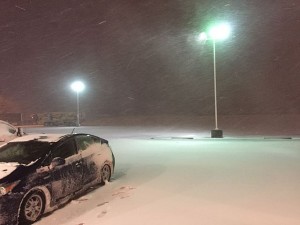 Print a Sign-In Sheet | Spanish Version
Print a Sign-In Sheet | Spanish Version
For many of us, a walk from the parking lot to our office, workstation, etc., is part of our daily work routine. During the winter, such a walk may present slip and fall hazards. Slip and fall accidents may increase due to the likelihood of snow and ice on stairs, ramps, slopes, parking lots and sidewalks.
Regardless of how well snow and ice are removed from parking lots and sidewalks, there may still be some slippery surfaces. It is very important for employees to understand the potential hazards and walk safely on slippery surfaces.
Employers may follow these prevention tips below to minimize the risk of falls.
Snow and Ice Removal Programs
-
- Plan prior to the winter months for snow and ice removal. If you elect to use third-party contractors for snow and ice removal, be sure to clearly determine responsibilities, timing, and priorities with regard to such removal.
- Monitor weather reports regularly. On nights when it snows, ensure snow and ice are removed early enough to accommodate employees arriving for normal shifts, but not so early as to allow for more snow accumulation.
- A rule of thumb is to remove snow once it reaches a depth of 3 inches. However, removing snow once it reaches 1 inch can help reduce the cohesion of additional snow.
- Always push snow to the lower end of the parking lot and as close to drains as possible. Keep snow piles away from parking lot entrances and exits so they do not obstruct drivers’ views.
- Pay extra attention to walkways, stairs, entranceways, ramps, slopes, and steel surfaces. Ensure there is adequate lighting and handrails on all stairs.
- Provide extra floor mats and replace saturated mats. Entranceways can get very slippery due to snow and ice. Use signs to warn employees and the public of wet floors.
- Ensure clear access to hydrants, utility shutoffs, sprinkler valves, and other emergency equipment.
Abrasives and Deicers
-
- Deicers, such as salt, can be used to accelerate the melting of ice and snow and make it easier to plow or shovel compacted snow. There are several varieties of salts that can be used depending on the situation. Some salts are less corrosive to metals or concrete.
- Abrasives, such as sand, are commonly used to provide more traction on ice. Other abrasives include sawdust, ashes, fly ash, cinders, cat litter, and lawn fertilizer.
- Be sure to wear gloves and eye protection when spreading deicers and abrasives by hand.
Other Tips
-
- Plan ahead to allow ample time to reach your destination.
- Wear shoes that provide better traction on snow and ice, such as rubber and neoprene composite. Avoid wearing plastic or leather-soled shoes. You can always change shoes once inside.
- Be careful when exiting your vehicle. Use the vehicle for support.
- Walk only in designated walkways. Do not walk over snow piles.
- Look for an alternate route. You may be able to walk along the grassy edge of an icy sidewalk rather than on the sidewalk.
- If you have no other alternative but to walk on ice, bend slightly, walk flat-footed with your center of gravity over your feet, and take short, shuffling steps.
KEMI does not assume liability for the content of information contained herein. Safety and health remain your responsibility. This information is to be used for informational purposes only and not intended to be exhaustive or a substitute for proper training, supervision, or manufacturers’ instructions/recommendations. KEMI, by publication of this information, does not assume liability for damage or injury arising from reliance upon it. Compliance with this information is not a guarantee or warranty that you will be in conformity with any laws or regulations nor does it ensure the absolute safety of any person, place, or object, including, but not limited to, you, your occupation, employees, customers, or place of business.

